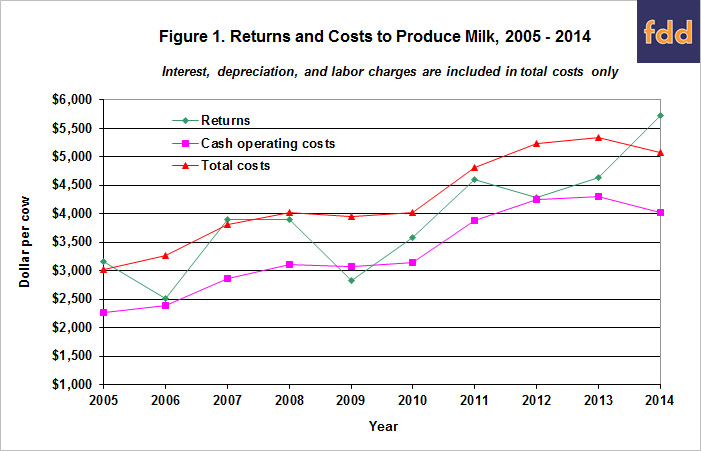Profit Margins for Dairy Producers Turn Positive in 2014, Likely to Return to Negative Trend in 2015

Higher milk prices and lower feed costs resulted in positive economic returns for Illinois dairy producers in 2014, according to figures summarized by University of Illinois agricultural economists in cooperation with the Illinois Farm Business Farm Management Association.
By: Bradley Zwilling, Brandy Krapf, and Dwight Raab, University of Illinois
The average net price received per 100 pounds of milk was $25.19, which was more than total economic costs of $22.35. The price received for milk in 2014 was the highest ever. On a per cow basis, total returns from milk were $5,730 compared to the total cost to produce milk of $5,068 per cow. Total returns from milk per cow were the highest on record. The returns per cow in 2013 were $4,642. Total returns have exceeded total economic costs three out of the last ten years.
Milk production per cow for all herds averaged 22,728 pounds. The average was 244 pounds more per cow than in 2013. This is the highest level in milk production per cow.
Costs and Returns
Trends in total costs and returns per cow for all herds are given from 2005 to 2014 in Figure 1. The profit margin (return above all cost) increased-- from a negative $701 in 2013 to $662 per cow in 2014. The last five-year returns above all costs has averaged a negative $325 per cow. During this period, returns above all costs per cow have varied from a negative $935 in 2012 to $662 in 2014. In Figure 1, labor and interest charges are included in total costs only. Most dairy producers will incur hired labor and cash interest expense and would include them as cash operating costs.
The 2014 returns were $6.12 per 100 pounds produced higher than the 2013 returns due to lower feed prices and higher milk prices. The average net price received for milk was $25.19 per 100 pounds. This is $4.56 per 100 pounds or 22 percent higher than the average price received in 2013. Based on 22,728 pounds of milk produced per cow, this increase in price increased total returns per cow by $1,036. The average net price received for milk for the last five-year period is $20.47 per hundred pounds. Dairy assistance payments from the Farm Service Agency and patronage returns related to the dairy enterprise would add about 8 cents per 100 pounds of milk produced to returns.
While the price received and non-feed costs per 100 pounds of milk increased, feed costs decreased per 100 pounds of milk produced. Feed costs in 2014 averaged $11.48 per 100 pounds of milk produced as compared to $13.46 in 2013. Feed costs were at their highest level ever in 2012. Feed costs have averaged $11.86 the last five years. The 2014 feed costs were 38 cents below the last five-year average. Feed costs were 51 percent of the total cost to produce milk. Non-feed costs per 100 pounds of milk produced were $10.87 in 2014 compared to $10.45 in 2013. Total non-feed costs were the highest ever.
Negative Profit Margins Likely for Dairy Producers in 2015
Costs will likely exceed milk prices in 2015 resulting in negative profit margins for dairy producers. Lower milk prices and higher non-feed costs will be the main reasons for the decrease in returns. The average price received for milk in 2014 was 22 percent higher than the average in 2013. The average milk price for 2015 is projected to be about 71 percent less, or about $7.30 per hundredweight lower than the average for 2014. Steady domestic demand and less exports will led to lower prices. United States milk production is expected to increase about 1.1 percent in 2015 due to low feed costs and increased milk production per cow.
While milk prices will decrease significantly, feed costs are expected to decrease as well. Corn and soybean prices remained lower than 2014 most of the year. Feed costs per 100 pounds of milk produced would average about $10.82 using prices of $3.70 per bushel for corn, 23 cents a pound for protein and $155 a ton for hay. This is based on annual feed consumption per cow, including replacement animals, of 102 bushels of corn, 5,036 pounds of protein, and 8.1 tons of hay or hay equivalents. If non-feed costs per 100 pounds of milk produced averaged $11.00, total costs to produce 100 pounds of milk would be $21.82. A 71 percent decrease in milk prices in 2014 for Illinois producers would result in an annual price of about $17.90 per 100 pounds. If total economic costs averaged $21.82 per 100 pounds of milk produced, the average Illinois producer would have returns below total economic costs by $3.92 per 100 pounds of milk produced.
The author would like to acknowledge that data used in this study comes from the local Farm Business Farm Management (FBFM) Associations across the State of Illinois. Without their cooperation, information as comprehensive and accurate as this would not be available for educational purposes. FBFM, which consists of 5,500 plus farmers and 60 professional field staff, is a not-for-profit organization available to all farm operators in Illinois. FBFM field staff provide on-farm counsel with computerized recordkeeping, farm financial management, business entity planning and income tax management. For more information, please contact the State FBFM Office located at the University of Illinois Department of Agricultural and Consumer Economics at 217-333-5511 or visit the FBFM website at www.fbfm.org.
A more thorough report can be found at the University of Illinois farmdoc website.







